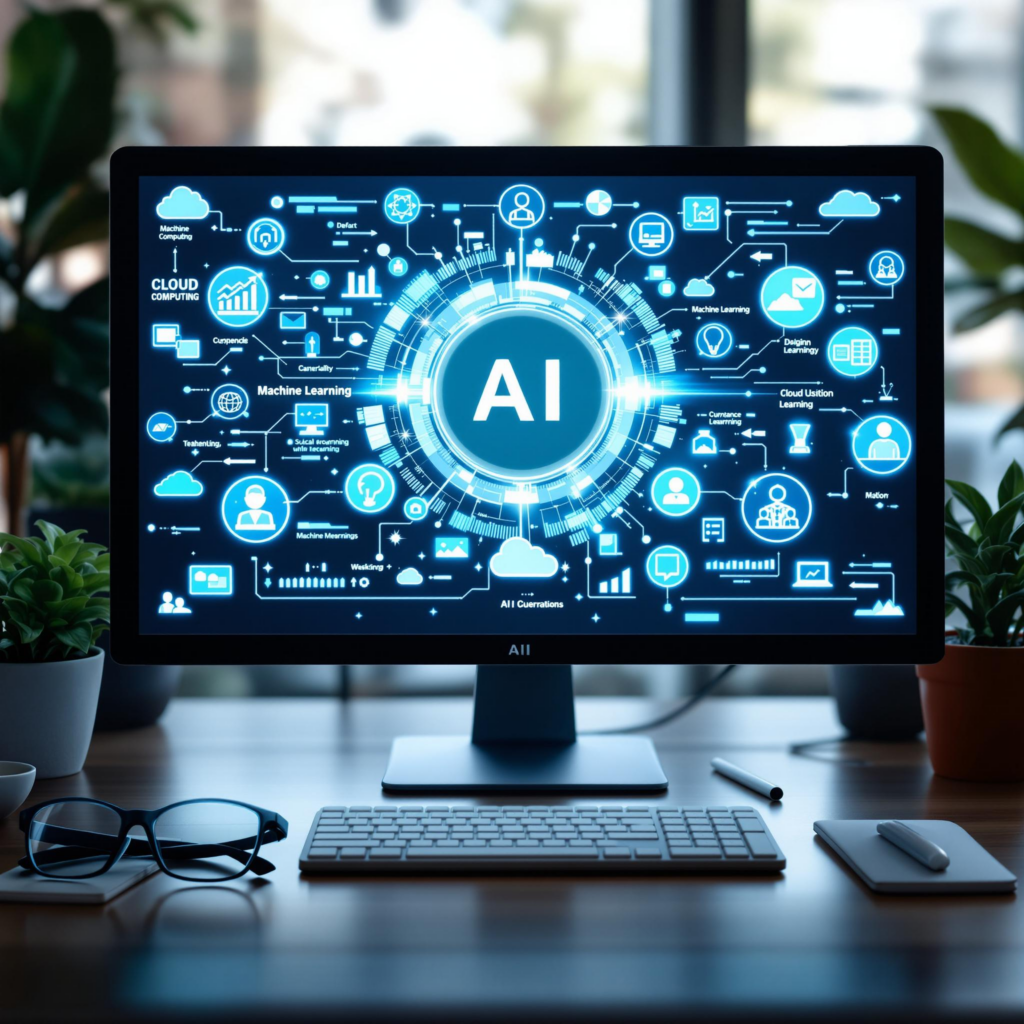As technology rapidly evolves, web design continues to adapt and innovate. Over the next decade, the industry will experience monumental changes driven by advancements in artificial intelligence, user experience, immersive technologies, and accessibility standards. Businesses and designers must prepare for a future where personalization, automation, and intuitive interfaces will redefine how websites are built and experienced. In this SEO-optimized blog post, we’ll explore key predictions shaping the future of web design and what they mean for the digital landscape.
1. AI-Driven Web Design Will Become Standard
Artificial intelligence (AI) is already streamlining workflows in web development. Over the next ten years, its role will expand drastically. AI-powered design assistants like Wix ADI and Bookmark’s AIDA are just the beginning. These tools use machine learning to suggest layouts, color schemes, and even generate content based on user input.
In the future, AI will not only assist but lead design creation. It will analyze user data in real time, adapting the interface to optimize conversions and engagement. Designers will shift from manual creators to strategic supervisors, refining AI-generated designs to better match brand identity and goals.
SEO Insight: AI will also enhance SEO implementation by automatically optimizing content for search engines, adjusting keyword density, meta descriptions, and alt texts without human intervention.
2. Hyper-Personalized User Experiences Will Dominate
Websites in the future will prioritize hyper-personalization. Instead of one-size-fits-all content, users will receive experiences tailored to their behavior, location, interests, and even emotions. Data analytics and AI will combine to deliver content dynamically based on browsing patterns and predictive analysis.
Imagine landing on a homepage that knows your shopping history, preferred color palette, and even the time you usually visit. This level of customization will increase engagement, reduce bounce rates, and enhance user satisfaction.
SEO Insight: Personalization will boost on-site engagement metrics, which are important for search rankings. Higher dwell time and interaction signal relevance to search engines.
3. Voice and Gesture Interfaces Will Redefine Navigation
Voice search is growing rapidly, thanks to smart assistants like Alexa, Google Assistant, and Siri. By 2035, a significant percentage of web navigation may be conducted through voice commands or even gestures.
Designing for voice requires a shift in structure. Websites will need clean, structured data (e.g., schema markup) and conversational content to ensure visibility and usability through voice interfaces. Meanwhile, gesture-based interactions—especially on wearable or AR devices—will introduce new layers of navigation.
SEO Insight: Voice search optimization demands natural language keywords and question-based queries. Expect a spike in “how,” “what,” and “where” searches, especially on mobile.
4. Immersive Technologies Will Transform User Interaction
Virtual reality (VR) and augmented reality (AR) will revolutionize how users experience websites. Already present in sectors like real estate, fashion, and gaming, these technologies will become widespread. AR product previews, VR showrooms, and 3D model interaction will become standard features.
Designers will need to master immersive design principles, balancing aesthetics with performance. Websites will evolve into interactive experiences rather than static pages.
SEO Insight: Rich, interactive content increases user time-on-page. Although Google doesn’t index 3D or VR content directly yet, integration with structured data and textual content ensures it contributes to rankings.
5. Mobile-First and Responsive Design Will Evolve into Device-Agnostic Design
Mobile-first is no longer optional—it’s expected. But the future demands more. As wearable tech, foldable screens, smart TVs, and even in-car displays gain popularity, web design will need to cater to a diverse ecosystem of devices.
Device-agnostic design will ensure websites look and function optimally across any screen. This will require fluid layouts, scalable vector graphics (SVGs), and responsive frameworks that adapt seamlessly to all environments.
SEO Insight: Google prioritizes mobile usability in its Core Web Vitals. A device-agnostic strategy will ensure websites maintain high rankings regardless of how they are accessed.
6. Sustainability and Green Design Will Gain Momentum
With digital carbon footprints becoming a growing concern, web design will shift toward sustainability. Designers will aim to reduce energy consumption by optimizing code, using fewer resources, and implementing efficient hosting solutions.
Minimalist design, lightweight images, and reduced JavaScript dependencies will improve load speeds and lessen server demands. This not only supports environmental goals but also enhances user experience.
SEO Insight: Google favors fast-loading, efficient websites. Faster speeds lead to better rankings and user satisfaction, reinforcing the move toward sustainable design practices.
7. Ethical and Inclusive Design Will Be Non-Negotiable
The next decade will see an increased focus on inclusive design. Web accessibility is becoming a legal requirement in many regions. Designers must ensure that digital experiences are usable for people with disabilities, including those using screen readers, keyboard navigation, or alternative input devices.
Moreover, ethical design considerations—like data privacy, user consent, and content transparency—will influence how sites are built and managed.
SEO Insight: Accessibility improvements, such as alt text and ARIA roles, contribute to better indexing. Furthermore, ethical practices can enhance brand trust, leading to more inbound links and better authority.
8. Neumorphism and Evolving Aesthetic Trends
Visual trends will continue to evolve, with styles like neumorphism, glassmorphism, and brutalism influencing web design. Neumorphism combines skeuomorphism and flat design, offering soft shadows and highlights that suggest physicality.
These styles must be applied with care, balancing visual appeal with usability. Accessibility and readability should never be sacrificed for aesthetics.
SEO Insight: Although design trends don’t directly impact SEO, they influence user engagement and time on site, which are important for search rankings.
9. Headless CMS and JAMstack Will Power Scalable Websites
Headless content management systems (CMS) like Strapi and Contentful allow developers to decouple the front end from the back end. This approach offers greater flexibility, scalability, and speed.
JAMstack (JavaScript, APIs, and Markup) will become the preferred architecture for modern websites, enabling faster load times and better security. Designers and developers will collaborate to deliver content via APIs to various platforms—from websites to mobile apps to digital signage.
SEO Insight: Headless CMSs can still support SEO through server-side rendering and pre-rendered static pages, ensuring performance and indexability.
10. Human-Centric Design Will Drive Strategy
As much as technology drives innovation, the future of web design remains grounded in human behavior. Emotional design, intuitive interfaces, and empathetic storytelling will take center stage.
Designers will use user testing, behavioral analytics, and feedback loops to refine UX. Anticipating user needs and minimizing cognitive load will result in designs that feel natural, engaging, and frictionless.
SEO Insight: Websites that resonate emotionally encourage sharing and repeat visits, which boost authority, backlinks, and organic traffic.
Final Thoughts
Web design is entering a transformative era. AI, immersive technologies, ethical standards, and personalized experiences will define the digital landscape. Designers must remain agile, continuously learning and adapting to new tools and trends. Businesses should invest in scalable, inclusive, and sustainable design practices that prioritize both user needs and performance.
By staying ahead of these trends and aligning design strategies with evolving user behaviors, organizations can future-proof their digital presence and maintain competitive advantages.
Key Takeaways for SEO and Web Design in the Next Decade:
- Prioritize performance metrics like Core Web Vitals and mobile responsiveness.
- Implement structured data for voice and AI interfaces.
- Embrace accessibility and privacy by design.
- Prepare for immersive technologies and non-traditional devices.
- Focus on personalization, speed, and sustainability.
The future of web design will be fast, adaptive, ethical, and deeply personalized. Those who embrace innovation while staying true to human-centered principles will lead the digital space in the coming years.
Stay Ahead: Evolve with the Future of Web Design
The next decade promises exciting developments for anyone invested in digital experiences. From AI and automation to inclusive and immersive designs, the future of web design will challenge outdated practices while rewarding those who innovate. Staying current is no longer optional—it’s essential for survival in a competitive, fast-paced online world.
Adapting to these trends means more than knowing what’s coming. It means rethinking your web strategy from the ground up. Are your systems flexible enough for device-agnostic design? Do your teams understand accessibility regulations? Have you integrated sustainable practices that improve both performance and eco-impact?
More importantly, is your website ready to meet users where they are—on any device, at any time, with the experiences they expect? If the answer is uncertain, now is the perfect time to act.
Let our expert team help you future-proof your web presence. We specialize in creating forward-thinking websites that balance performance, beauty, and user experience. Whether you’re redesigning an outdated platform or building something new from scratch, we’ll guide you with strategic insights and cutting-edge solutions tailored to your goals.
Don’t wait for the future to arrive—build it today. Connect with us now to explore how our custom web design services can position your brand at the forefront of the digital revolution.
Ready to future-proof your website? Our expert team designs fast, accessible, and innovative digital experiences built for tomorrow’s users. Whether you’re starting fresh or upgrading an existing site, we bring strategy, creativity, and cutting-edge technology to every project. Let’s build a website that adapts, performs, and stands out in a competitive digital world.
Contact us today to elevate your online presence and stay ahead in the evolving landscape of web design.


One Response
Having purchased this insightful piece about modern web design trends, the experience has been nothing short of extraordinary. The comprehensive analysis presented in The Future of Web Design: Predictions for the Next Decade truly resonates with anyone passionate about evolving digital aesthetics and user engagement. It’s refreshing to see predictions backed by data and industry observations that not only highlight where things are headed but also offer practical advice applicable immediately.
Quality stands out in every aspect, from the in-depth research to the engaging design layout. The content is well-organized and easy to follow, making complex ideas accessible without diluting the technical depth needed by both casual readers and seasoned professionals. The thought-provoking nature of the predictions encourages one to rethink current design practices and consider future-proof strategies, which is incredibly valuable in today’s fast-paced digital landscape.
Holding a keen interest in web design services, the materials provided feel like a personal conversation with a mentor rather than a straightforward presentation. The blend of expert insights and forward-thinking design recommendations not only demonstrates the immense value of the website but also harnesses creativity and technical prowess in equal measure. The design elements feel modern and sleek, which further reinforces the credibility and current relevancy of the insights provided.
The overall presentation reflects the dedication and expertise of the creators, making it a must-read for anyone looking to stay ahead in the competitive world of digital design. With a balanced mix of vision and practicality, the predictions serve not just as a guideline, but as an invitation to embrace change and explore innovative solutions. In conclusion, this resource comes highly recommended for those who appreciate quality analysis paired with forward-thinking design ideologies. Certainly, it’s a worthwhile investment for anyone committed to understanding the future trends in web design.